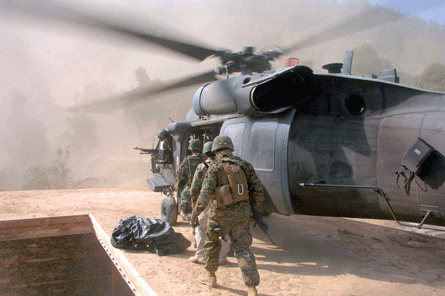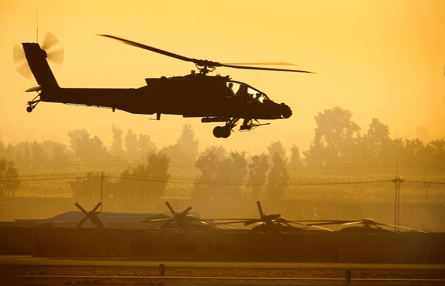The two teams competing to build the successor to the General Electric T700 - one of the most successful helicopter engine programmes ever- are preparing for a critical phase of testing.
Meanwhile, the US Army continues to debate how much thrust it needs for a next-generation engine and whether there should be an all-new airframe to harness its potential.
The army launched the advanced affordable turbine engine (AATE) programme with a pair of contracts awarded in 2007. GE began developing the GE3000 demonstrator and Advanced Turbine Engine (ATEC), a joint venture formed between Honeywell and Pratt & Whitney, started work on the HP3000.
 |
|---|
© US ArmyUH-60 Black Hawks have been constrained by the limits of their engines during current operations in Afghanistan |
The goals for both are to reduce specific fuel consumption by 25% compared with the T700-701C, while keeping the engine within the same size and weight. By setting the thrust objective at 3,000shp (2,235kW), the army wants to boost by half the power available to future Sikorsky UH-60 Black Hawk and Boeing AH-64 Apache variants, as well as perhaps an all-new replacement aircraft after 2020.
In addition to the military applications, a huge commercial market also awaits the winner of the race to replace the T700. The commercial CT7 engine family, derived from the T700, powers more than 50 aircraft types. Although both manufacturers say they are focused only on the military requirement, an all-new centreline engine that delivers 50% more power than the T700 but requires no extra space will attract commercial interest too.
COMMERCIAL INTEREST
"You would expect that the commercial applications would certainly be interested in this, given the benefits of improved specific fuel consumption and increased power to weight," says Mike Sousa, project manager for the GE3000 technology demonstrator programme, adding: "I don't see the commercial market driving the requirement for it."
ATEC officials also want to focus on the military programme, but concede the potential opportunity. "We don't know what's going to happen on the commercial side during the next eight to 10 years," says Skip Scipioni, P&W general manager of army business development. "There could be a lot of new developments out there requiring this size engine, but we don't know that yet."
While the demonstrator competition continues, army officials are already moving forward with plans for a potential engine fly-off after 2016. In July, the army notified industry that the improved turbine engine programme (ITEP) could begin immediately after the AATE demonstration ends in 2011. Either one or both of the teams involved in AATE could be selected to continue for ITEP.
Both GE and ATEC confirm that they are now preparing to stage core tests scheduled for mid- to late 2010. "We've got [component rigs] that are essentially on test now," Sousa says. ATEC officials confirm that the HPW3000 has also begun rig tests.
Both the GE3000 and HPW3000 are the prime candidates to replace GE's venerable T700/CT7-series family of engines, which has dominated its class for three decades.
STEP CHANGE
But the T700 is beginning to fall short of the army's requirements. Maximum power for the T700-701D, the latest type model in the series, is 1,995shp, a step change below the power requirements set for the next engine designed for the same class of helicopters.
Both the Apache and Black Hawk fleets have been constrained by the limits of their engine during current operations. The army has resorted to using Boeing CH-47 Chinooks for roles traditionally assigned to UH-60s, but face new limitations in the high altitudes and temperatures encountered during operations in Afghanistan and Iraq.
 |
|---|
© US Air ForceApaches, like Black Hawks, are affected by a shortage of power in places such as Iraq |
Age also has inevitably added weight to the Sikorsky workhorse. P&W's Scipioni, representing ATEC, says more than 500 engineering change proposals have added 1,020kg (2,245lb) to the UH-60 airframe. Another mission equipment package add-on for desert operations adds about 450kg more he says.
"As aircraft get heavier they're being used at hotter and higher conditions. That challenges aircraft," Sousa says. "This is an opportunity to have enough power so they are not limited by the engine going forward."
Neither the UH-60M nor the AH-64D currently have capacity in their gearbox, transmission, rotor blades and tail-rotor authority to support a 50% power upgrade for the engine. The army is already investing in development programmes to address those shortfalls.
In the meantime, the potential power boost that comes with either the HPW3000 or GE3000 would allow pilots to gain the maximum performance from all those systems.
"This will help recover some of the payload lost by these [mission equipment package] add-ons and give them better 'high-hot' performance and range," Scipioni says. "That gives the option on shorter radius missions to trade fuel for payload as you're getting better range."
For the long term, both engine manufacturers are already looking beyond upgrades for the AH-64 and UH-60 fleets. The army has also proposed launching a new-start programme called the Joint Multi-Role (JMR), which could replace the UH-60 and AH-64 with a common airframe after 2020.
Army aviation officials at Fort Rucker, Alabama are conducting a capabilities-based assessment, analysing the future needs for such an aircraft. A separate study on the joint multi-role requirement is also under way within the US Department of Defense.
Although it would be rare to launch a new centreline engine without a new airframe at least in consideration, it remains uncertain for both engine manufacturers how either the GE3000 or HPW3000 might be leveraged for the potential JMR requirement. "That option remains on the table," Scipioni says.
The ongoing study has not determined whether the JMR will need an engine in the same 3,000shp class. "That's what they haven't decided yet," he says. The JMR "could be a little bit larger or a little bit smaller than 3,000".
Sousa basically agrees with his competitor. "Depending on which one of the airframers you talk to about what their vision of what a JMR might be, either the [improved turbine engine] might meet the requirement or it might not meet the requirement," Sousa says. "It just seems premature for JMR to be driving the requirements for the engine."
With the development process in its early stages, both competitors are careful to discuss any details of their engine configuration. It remains unclear, for example, how even development tasks are assigned between Honeywell and P&W within the ATEC venture.
GE, meanwhile, has introduced first-generation 3D aerodynamic design features to the later version of the CT7 engine family, and plans to offer a "more aggressive" configuration on the GE3000, Sousa says.
The ATEC team has revealed one element of engineering strategy for the HPW3000. The engine is designed to potentially eliminate the need for an auxiliary power unit, which usually provides the power to start the engine and operate certain aircraft systems.
APU ELIMINATION
"We could be used as an APU if the army so chose to do that, which would eliminate the APU infrastructure within the airframe," Scipioni says - but designing the engine to serve as the APU is just a proposal, he adds.
"That would have to be looked at by the [original equipment manufacturers]," Scipioni says. "The army would also have to endorse that capability. But we would throw that attribute on the table."
Whether or not an airframer or the army decides that the HPW3000 should make the APU redundant, ATEC's powerplant will be able to be started by battery power alone, Scipioni adds. "There is potential for airframe cost reduction and systems cost reduction," he says, but "there would have to be studies".
GE officials are sceptical that the APU will be a factor in competition, although the GE3000 configuration does not rule out the option, Sousa says. "We would like the engine to be as flexible as it can be," he adds. "I'm not sure we feel the ability to eliminate APUs is going to be the driving factor going forward."
Eliminating the APU provides extra weight and space but at the cost of burning more fuel by using the main engine to drive accessory systems. "You can't imagine them eliminating APUs on large military helicopters like Black Hawks or Apaches, " Sousa says.
Source: Flight International












































